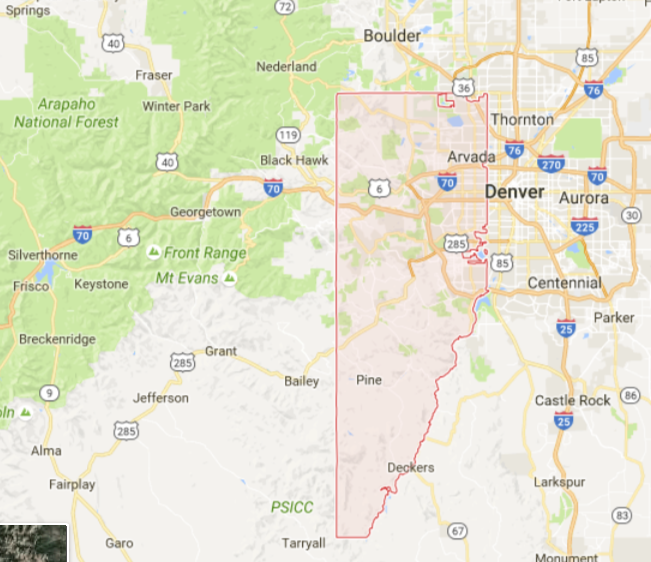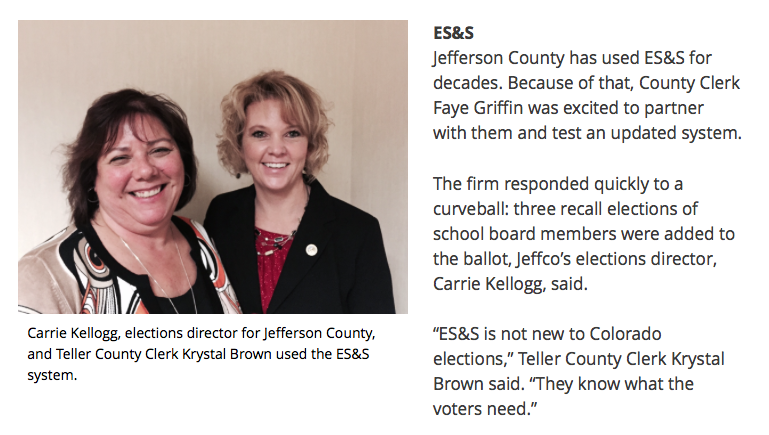 Our colleague Jim March Simpson of BlackBoxVoting.org and AUDIT AZ noticed one county in Colorado that has the ES&SDS850 machines, which are capable of using numerically pegged ballot images. ES&S DS850 ballot images are a part of the chain of custody for the election. For the people of Jefferson County, these images can also be used to verify the tabulation in that county by comparing the ballot images to a statistically significant random sample of their corresponding ballot images.
Our colleague Jim March Simpson of BlackBoxVoting.org and AUDIT AZ noticed one county in Colorado that has the ES&SDS850 machines, which are capable of using numerically pegged ballot images. ES&S DS850 ballot images are a part of the chain of custody for the election. For the people of Jefferson County, these images can also be used to verify the tabulation in that county by comparing the ballot images to a statistically significant random sample of their corresponding ballot images.
The only feasible reason for deleting these ballot images is to accommodate cheating in the upcoming general election.
We need a volunteer within Colorado to issue a Temporary Restraining Order (TRO) for the Jefferson County Elections Department to stop destroying evidence in the form of ballot images. Here is a sample of a TRO.
https://drive.google.com/file/d/0B2TKmkSNAkCfWHhjTnM3MG0zS00/view
To get help in filing that restraining order before the election, contact:
Jim March (1.jim.march@gmail.com)
or
John Brakey
johnbrakey@gmail.com
520-339-2696

To:
Carrie Kellogg | Director of Elections
Jefferson County Elections Division
Direct: 303-271-8106 | Email: ckellogg@jeffco.us
Ms. Kellog,
I need to inform you that you are making a very, very serious mistake in your public records response and in how you are handling important public records in your county. The mistake is caused by a basic failure to understand how modern technology works. To help you rectify the situation before your mistake costs your taxpayers very significant amounts of money, I need to explain by way of analogy.
Picture a county government white collar job of some sort that is very high profile but is staffed with two part-time workers. They share an office (or cubicle) and a single computer – one in the morning, one in the afternoon. The one computer is password protected and again, they share the same computer.
They need to exchange messages between each other but don’t want to have those messages available under public records, because they’re both crooks. The computer is rigged up by the county IT office such that you can’t save files to any local disk – all saves get stored on a file server somewhere that is archived by IT and they can’t reliably erase anything.
So our two crooks come up with an idea: they will open up a really simple, primitive word processing program, like Notepad in MS-Windows or any number of equivalents that don’t auto-save. They type messages into the word processor where the text is displayed on-screen and is held in RAM – “Random Access Memory” which auto-deletes itself whenever the computer is rebooted. They deliberately don’t save to disk, either local or on the server. One types a message for their fellow conspirator, locks the screensaver so nobody else can see the screen, walks away. When the next crook comes in, they look at the document on-screen and then reboot the computer, clearing the RAM.
Here’s the question: by deliberately not saving to disk, are they making sure there’s no public record?
Answer: NO.
The document IN RAM is a public record. They deliberately failed to preserve it. They cannot claim later there was no public record.
That is exactly your situation.
When your ballot scanning system reads the ballot into RAM, it is at that moment a public record, just like the crooked messages in my analogy. That copy of the ballot image in RAM is then processed to generate a set of vote records which flow into a central vote tabulator’s database where they are demonstrably easy to alter – including by the way the audit log for that database. One of the organizations I am connected to went so far as to teach an actual Chimpanzee how to do it on one system:
https://www.youtube.com/watch?
The graphic ballot scans you have set to auto-delete are a product of newer technology voting machines. Those scans are a valuable public record audit tool that exist between the original paper ballot and the final electronic tally. They were meant as an audit tool; they are absolutely a public record.
It isn’t that there’s no public record here – it’s understood that I cannot compel you to create a public record. The issue is that you are deliberately destroying them by way of a simple software setting that the vendor should never have included.
You are in Colorado, a state that takes public records laws very seriously with cash penalties against state and local agencies that hide public records, let alone destroy them. If you destroy these records or otherwise fail to release them if you do keep them (after of course a delay to finish the election processing) a court is going to judge your actions.
I recommend you avoid that.
Jim Simpson
Dear Mr. March Simpson
The County Clerk and Recorder is in receipt of your request dated October 30, 2016 for the electronic copies and cast vote records for the 2016 General Election. The ballot images you are requesting will not be available for this election. All votes will be downloaded and saved for election results reporting, however, the ballot images are not being saved during the scanning process. While the cast vote records will be available in PDF format, we ask that you please confirm that you would still like the cast vote records even though the ballot images are not available.
We will be conducting the post-election audit in accordance with §1-7-514 CRS and Colorado Secretary of State Rule 11.3.3 which does not require digital ballot images. In 2017, we will make the transition to the approved voting system that supports digital images.
Thank you
Carrie Kellogg
Carrie Kellogg | Director of Elections
Jefferson County Elections Division
Direct: 303-271-8106 | Email: ckellogg@jeffco.us
The answer also contains a bit of misdirection. Asking for the preservation of ballot images in no way interferes with their post election audit. The post election audit as described, however, cannot detect the use of “Fraction Magic”, which is a form of election fraud that has been proven to be a built-in part of these election systems. The audit perform by the Colorado Secretary of State’s office will not be able to detect “Fraction Magic”.



Pingback: Is the Easter Egg Hunt in Wisconsin, Michigan and Pennsylvania Clinton’s “Plan B”? – Cafe Aftermath
[…] for Hillary Clinton, it was surprising to watch Greg Palast introduce the fact that many of these voting districts disabled the crucial ballot imaging function on the newer machines on Democracy Now! in an effort to make the case that the election was rigged […]